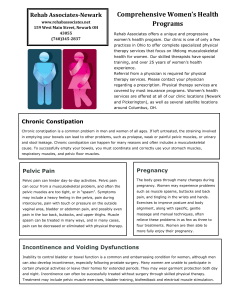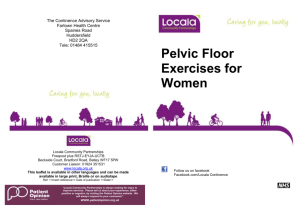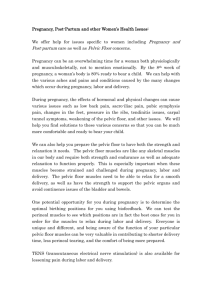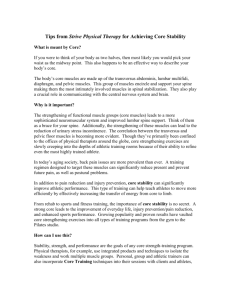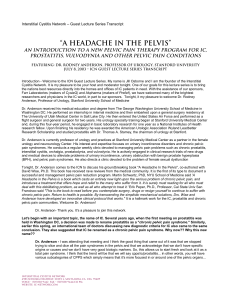Document 10977408
advertisement
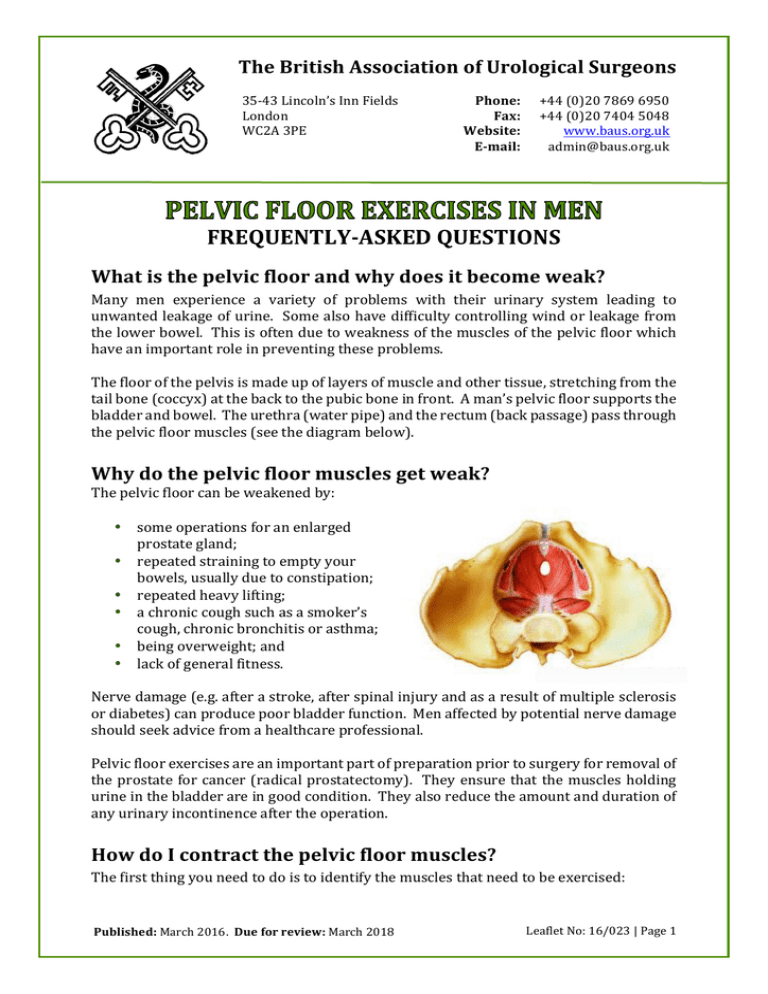
The British Association of Urological Surgeons 35-­‐‑43 Lincoln’s Inn Fields London WC2A 3PE Phone: Fax: Website: E-­‐‑mail: +44 (0)20 7869 6950 +44 (0)20 7404 5048 www.baus.org.uk admin@baus.org.uk FREQUENTLY-­‐‑ASKED QUESTIONS What is the pelvic floor and why does it become weak? Many men experience a variety of problems with their urinary system leading to unwanted leakage of urine. Some also have difficulty controlling wind or leakage from the lower bowel. This is often due to weakness of the muscles of the pelvic floor which have an important role in preventing these problems. The floor of the pelvis is made up of layers of muscle and other tissue, stretching from the tail bone (coccyx) at the back to the pubic bone in front. A man’s pelvic floor supports the bladder and bowel. The urethra (water pipe) and the rectum (back passage) pass through the pelvic floor muscles (see the diagram below). Why do the pelvic floor muscles get weak? The pelvic floor can be weakened by: • some operations for an enlarged prostate gland; • repeated straining to empty your bowels, usually due to constipation; • repeated heavy lifting; • a chronic cough such as a smoker’s cough, chronic bronchitis or asthma; • being overweight; and • lack of general fitness. Nerve damage (e.g. after a stroke, after spinal injury and as a result of multiple sclerosis or diabetes) can produce poor bladder function. Men affected by potential nerve damage should seek advice from a healthcare professional. Pelvic floor exercises are an important part of preparation prior to surgery for removal of the prostate for cancer (radical prostatectomy). They ensure that the muscles holding urine in the bladder are in good condition. They also reduce the amount and duration of any urinary incontinence after the operation. How do I contract the pelvic floor muscles? The first thing you need to do is to identify the muscles that need to be exercised: Published: March 2016. Due for review: March 2018 Leaflet No: 16/023 | Page 1 • sit or lie comfortably with the muscles of your thighs, buttock and abdomen relaxed; • tighten the ring of muscle around the back passage as if you are trying to control diarrhoea or wind. Relax the muscle again. Practice this movement several times until you are sure you are exercising the correct muscles. Try not to squeeze you buttocks, tighten your thighs or contract your tummy muscles; and • imagine you are passing urine, trying to stop the flow in mid-­‐‑stream and then re-­‐‑ starting it. If your technique is correct, you will feel the base of your penis move upwards slightly towards your tummy. You can do this “for real” while passing urine but do not do this more than once a week to check your progress, otherwise it may interfere with normal bladder emptying. How do I do pelvic floor exercises? • tighten and draw in the muscles around the anus (back passage) and the urethra (water pipe) all at once. Lift them up inside and hold this position as you count to five. Release the muscles slowly and relax for a few seconds; • repeat the contraction and relax again. Once you find it easy to hold the contraction for a count of five, try to hold it for longer (up to ten seconds); • repeat this for a maximum of eight to ten squeezes. Try to make each contraction strong, slow and controlled; • do the same thing again but, this time, using ten short, fast contractions, pulling up rapidly and immediately letting go; • repeat this whole exercise routine at least four to five times every day. You can do it in a variety of positions -­‐‑ lying, sitting, standing and walking; and • try to avoid holding your breath, pushing down (instead of squeezing) and tightening your tummy, buttocks or thighs. Are there any other things that help? Once you have learnt how to do these exercises, they should be done regularly, giving each set your full attention. Find at least five regular times during the day to do them e.g. after going to the toilet, when having a drink, when lying in bed. Tightening the pelvic floor before you get up from a chair, cough or lift anything heavy will also help. You will probably not notice an improvement for several weeks and will not reach maximum effectiveness for a few months. Once you have recovered control over your bowel and bladder, continue doing the exercises twice a day for life. • share the lifting of heavy loads; • avoid constipation and straining during a bowel movement; • seek medical advice for hay fever, asthma or bronchitis to reduce sneezing and coughing; • keep your weight within the right range for your height and age; • other methods which have been shown to help some men include biofeedback and electrical stimulation. Published: March 2016. Due for review: March 2018 Leaflet No: 16/023 | Page 2 Consult your urologist or specialist nurse for more details. How do I get more information? You can obtain more information about continence problems from: The Continence Foundation 307 Hatton Square 16 Baldwins Gardens London EC1N 7RJ (Phone 020 7831 9831) www.continence-­‐‑foundation.org.uk Are there any other important points? This booklet includes advice from specialists, the British Association of Urological Surgeons, the Department of Health and other sources. You should read this booklet with any advice your GP or other healthcare professional may already have given you. Alternative treatments can be discussed in more detail with your urologist or specialist nurse. Disclaimer While we have made every effort to be sure the information in this booklet is accurate, we cannot guarantee there are no errors or omissions. We cannot accept responsibility for any loss resulting from something that anyone has, or has not, done as a result of the information in this booklet. © British Association of Urological Surgeons (BAUS) Limited Published: March 2016. Due for review: March 2018 Leaflet No: 16/023 | Page 3
